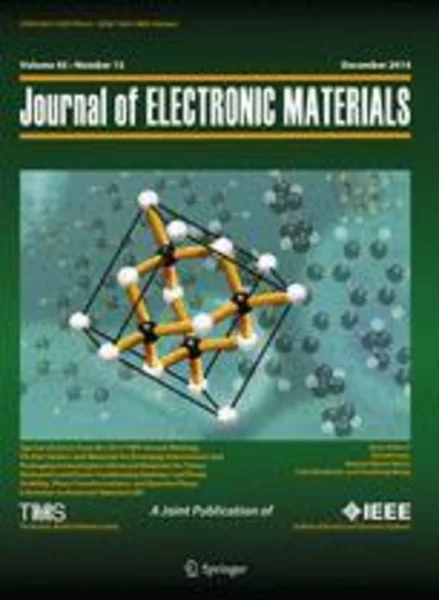-
transformation-induced plasticity in sn-in solder joints
جزئیات بیشتر مقاله- تاریخ ارائه: 1392/07/24
- تاریخ انتشار در تی پی بین: 1392/07/24
- تعداد بازدید: 822
- تعداد پرسش و پاسخ ها: 0
- شماره تماس دبیرخانه رویداد: -
the research reported here concerns the contribution of transformation- induced plasticity (trip) to the shear deformation of sn-x wt.%in solders with cu or ni metallization, where the in content (x) ranges from 9 wt.% to 15 wt.%. in this concentration range the high-temperature γ-phase (hexagonal structure) transforms to the low-temperature β-phase (β-sn structure) on cooling, and the transformation can be martensitic. the results show that sn-9in and sn-11in solder joints do exhibit trip that significantly enhances their ductility when tested at temperatures between the deformation-induced martensite temperature (m d) and the stress-induced martensite temperature (my). for sn-9in, m d ≈ 105°c, and the trip effect is optimal near m y ≈ 80°c, where the total elongation reaches ~100% when the substrate metallization is cu. the trip elongation is less spectacular with ni metallization because of weakness at the solder–substrate interface. sn-11 wt.%in joints also show extensive trip effect, with an m d temperature near 60°c, and an m y of 35°c or less. the total elongation of 11 wt.% in joints on cu reaches 350% at 35°c. sn-15 wt.%in joints with cu metallization also have excellent ductility at low temperature, with total elongation of ~50% at 35°c. in this case, however, the excellent ductility is due to the fine-grained, two-phase microstructure of the solder rather than any trip effect.
مقالات جدیدترین رویدادها
-
استفاده از تحلیل اهمیت-عملکرد در ارائه الگوی مدیریت خلاقیت سازمانی و ارائه راهکار جهت بهبود
-
بررسی تاثیر ارزش وجوه نقد مازاد بر ساختار سرمایه شرکت های پذیرفته شده در بورس اوراق بهادار تهران
-
بررسی تأثیر سطح افشای ریسک بر قرارداد بدهی شرکت های پذیرفته شده در بورس اوراق بهادار تهران
-
بررسی تأثیر رتبه بندی اعتباری مبتنی بر مدل امتیاز بازار نوظهور بر نقد شوندگی سهام با تأکید بر خصوصی سازی شرکت ها
-
تأثیر آمیخته بازاریابی پوشاک ایرانی بر تصویر ذهنی مشتری پوشاک ایرانی (هاکوپیان)
-
محقق سبزواری و جایگاه حاکم دراخلاق سیاسی
-
بررسی رویکرد روانشناسی محیطی در ایجاد فضاهای آموزشی برای کودکان مبتلا به بیماری اتیسم
-
عوامل کیفی تاثیرگذار بر تعاملات اجتماعی در طراحی مجتمع های تجاری
-
بررسی تاثیر سبک زندگی ساکنین ایران پیش از اسلام بر کالبد و معنای چهارطاقی
-
removal of pb2+ ions from contaminated solutions by microbial composite: combined action of a soilborne fungus mucor plumbeus and alunite matrix
مقالات جدیدترین ژورنال ها
-
مدیریت و بررسی افسردگی دانش آموزان دختر مقطع متوسطه دوم در دروان کرونا در شهرستان دزفول
-
مدیریت و بررسی خرد سیاسی در اندیشه ی فردوسی در ادب ایران
-
واکاوی و مدیریت توصیفی قلمدان(جاکلیدی)ضریح در موزه آستان قدس رضوی
-
بررسی تاثیر خلاقیت، دانش و انگیزه کارکنان بر پیشنهادات نوآورانه کارکنان ( مورد مطالعه: هتل های 3 و 4 ستاره استان کرمان)
-
بررسی تاثیر کیفیت سیستم های اطلاعاتی بر تصمیم گیری موفق در شرکتهای تولیدی استان اصفهان (مورد مطالعه: مدیران شرکتهای تولیدی استان اصفهان)
-
بررسی تاثیر شش سیگما بر عملکرد مالی شرکت با تمرکز برفرآیندهای حسابداری
-
مدیریت رفتار مشتریان مبتنی بر ایجاد ارزش با رویکرد داده کاوی و منطق فازی
-
بهره مندی سپاه قدس از ظرفیت بسیجیان استان گیلان در تحقق اقتصاد مقاومتی
-
طراحی خانه موسیقی سنندج با تاکید بر نقش موسیقی فولکلور در معماری
-
واکاوی مؤلفه های دوستی از منظر امام علی علیه السلام




سوال خود را در مورد این مقاله مطرح نمایید :